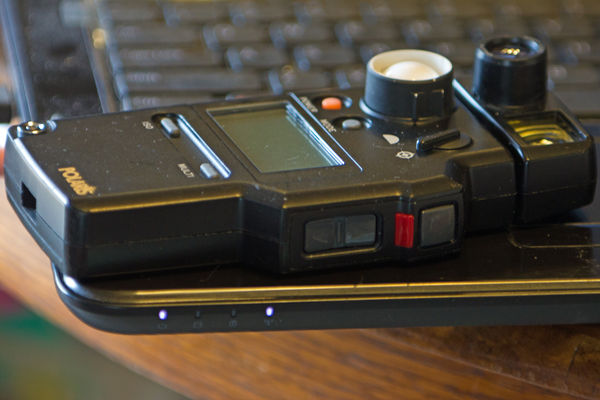More on The Subject of Light Meters
Mar 11, 2012 09:47:57 #
rambler wrote:
Great info and explanations. I did not realize one had to cover up the dome when facing a flash.
You don't.
What he's referring to is making the meter more "directional" by shielding it from the other flashes in the room.
Sekonic meters have this feature (except for the L-308) where the sleeve slides up around the dome so less flash "bleeds in" from the side.
You can achieve the same thing by only firing your flashes one at a time or by cupping your hand around the dome (like an impromptu tube) or by making a "shield" tube thingy...
In my experience, it's not absolutely necessary unless you are getting down to the 1/10 stop area.
Check out the picture..can you see how the dome is sort shielded by the black ring thing? If you rotate the ring, it makes the dome stick out more like in the second shot below.


Mar 11, 2012 09:53:43 #
Mar 11, 2012 09:53:56 #
If I may jump in here...
That is correct, I guess I should have been a little more clear about that not taking into account that some light meters do not have this option.
Good reply....thanks!
That is correct, I guess I should have been a little more clear about that not taking into account that some light meters do not have this option.
Good reply....thanks!
rpavich wrote:
quote=rambler Great info and explanations. I did... (show quote)
Mar 11, 2012 09:54:04 #
rambler wrote:
Great info and explanations. I did not realize one had to cover up the dome when facing a flash.
I think you will find that the white dome is what he is referring to, unless you are referring to the flat defuser. You can see it in place on the Polaris Dual 5 meter shown. Thanks to rpavich for verifying what this is for me the other day.
Jim D

Mar 11, 2012 10:22:15 #
I just wanted to say thanks to Designpro for a great contribution. I just purchased a used Sekonic L-358, a few steps below the model you use, but a good starting point for me. I found your article very helpful and a good introduction to the use of these instruments.
Thanks!
Thanks!
Mar 11, 2012 10:36:28 #
I just compared 3 light meters without compensation.
Target UHH screen. ISO 100 Aperture f8. Spot meter single point.
Sekonic L758xx 1/15 sec
iPod Light meter APP 1/5 sec
Nikon D7000 1/4 sec
In the Sekonic only thread I will be posting results using the current Sekonic software to adjust the Sekonic.
When and if I get it to work.
It is complicated. You do not just turn a screw.
Target UHH screen. ISO 100 Aperture f8. Spot meter single point.
Sekonic L758xx 1/15 sec
iPod Light meter APP 1/5 sec
Nikon D7000 1/4 sec
In the Sekonic only thread I will be posting results using the current Sekonic software to adjust the Sekonic.
When and if I get it to work.
It is complicated. You do not just turn a screw.
Mar 11, 2012 10:38:04 #
Yes, a very thorough explanation and thank you.A point you mentioned i hadn't thought about..turning down the display to save battery power has resulted in a slight under-exposure at times.
What initially makes me think one should back off a bit on advocating a handheld meter is the sheer # of relative new people to photography already struggling with exposure and
taking every bit of information seriously,not knowing the difference between an incident or reflective meter,thinking they need to go buy one even though they don't even know they have a meter in their camera. In some way i think we need to distinguish these people from the more experienced people who want to use an incident meter for
a particular reason.
What initially makes me think one should back off a bit on advocating a handheld meter is the sheer # of relative new people to photography already struggling with exposure and
taking every bit of information seriously,not knowing the difference between an incident or reflective meter,thinking they need to go buy one even though they don't even know they have a meter in their camera. In some way i think we need to distinguish these people from the more experienced people who want to use an incident meter for
a particular reason.
Mar 11, 2012 11:17:17 #
Good luck, I hope you don't have to hard a time doing the adjustment.
randymoe wrote:
I just compared 3 light meters without compensation.
Target UHH screen. ISO 100 Aperture f8. Spot meter single point.
Sekonic L758xx 1/15 sec
iPod Light meter APP 1/5 sec
Nikon D7000 1/4 sec
In the Sekonic only thread I will be posting results using the current Sekonic software to adjust the Sekonic.
When and if I get it to work.
It is complicated. You do not just turn a screw.
Target UHH screen. ISO 100 Aperture f8. Spot meter single point.
Sekonic L758xx 1/15 sec
iPod Light meter APP 1/5 sec
Nikon D7000 1/4 sec
In the Sekonic only thread I will be posting results using the current Sekonic software to adjust the Sekonic.
When and if I get it to work.
It is complicated. You do not just turn a screw.
Mar 11, 2012 11:27:40 #
no rocket science with my little 308....just aim at the light source and press a button...or activate flash mode at set off your flash....
i get perfect exposures every time. no muss, no fuss
i have never had an electronic item that worked any easier than this....and it works like it's supposed to every time.
absolutely the best accessory i have EVER purchased.
i get perfect exposures every time. no muss, no fuss
i have never had an electronic item that worked any easier than this....and it works like it's supposed to every time.
absolutely the best accessory i have EVER purchased.
Mar 11, 2012 11:29:32 #
Lucky!
jimberton wrote:
no rocket science with my little 308....just aim at the light source and press a button...or activate flash mode at set off your flash....
i get perfect exposures every time. no muss, no fuss
i have never had an electronic item that worked any easier than this....and it works like it's supposed to every time.
absolutely the best accessory i have EVER purchased.
i get perfect exposures every time. no muss, no fuss
i have never had an electronic item that worked any easier than this....and it works like it's supposed to every time.
absolutely the best accessory i have EVER purchased.
Mar 11, 2012 11:39:09 #
jenny wrote:
Yes, a very thorough explanation and thank you.A p... (show quote)
Jenny...please understand....step back a second and read what I'm about to write ok?
Think about what I'm about to say with an open mind.
The confusion you mentioned is PRECISELY the reason for a meter recommendation...and PRECISELY why people are confused.
What is more confusing:
1.) Having conflicting readings depending on what tones are in the scene and when recomposing the shot finding that their meter now reads differently and then wonder what the actual reading should be.
Having to second-guess your meter depending on what the predominate tones are in the scene (snow, sand, beach, sidewalk, grass, etc)
Trying to keep all the suggestions and rules in mind when shooting a scene (white bird against grassy background = stop up 1 or two stops, dark car against dark background = stop down 1 or two stops, dark shirt, light pants, dark hair, backlit = who knows?)
Chimp, chimp and more chimp....
VS
2.) Meter for the scene, set your camera to what the meter says.
THAT'S why we keep suggesting a meter...not only does it CUT DOWN on confusion, but it is a great tool to LEARN about light.
How many threads are there on the UHH where someone has come out with an under or over exposed shot and is asking why it happened and it was because their camera was fooled and they didn't have the expertise to know how and when to second-guess their particular camera in that particular scene?
Lots.
Does that make sense?
Mar 11, 2012 11:59:41 #
rpavich wrote:
quote=jenny Yes, a very thorough explanation and ... (show quote)
Yes, certainly! I think you recommended a meter about two days ago,and we had a reasonable exchange i think with my reply about newbies when immediately some poor soul posted an inquiry,"What's a meter?" Then you had to gove that person an explanation that there is one in the camera. It so often happens that two people may be "on the same page" but on a different plane. I would not in any way think to disagree with someone who recommends a handheld meter,but we both know it's way beyond the reach of someone who doesn't know what one is. It's not uncommon that sometimes the simplest statement gets blown all out of proportion for that reason. Just so you know, i have nothing against handheld meters, or the opinions of those who recommend them. It makes me uncomfortable though for those in a "fog" with the camera they have,trying to learn to use it,never learning it thoroughly,thinking if they get a new camera with more automatic features at a higher price,they will then "take" better pics out of it...it's an old story isn't it.
Mar 11, 2012 12:09:42 #
ole sarg
Loc: south florida
All this talk is about taking the fun out of photography. As a combat photographer, a news photographer, and just a hobby shooter I never went through all the trouble mentioned above. I just did not have time or inclination to calibrate the meter I never had in VN. I just used sunny 16. As a news photographer, used a light meter, or sunny 16 but the meter was out of the box and it was close enough. As a hobby shooter just use the in camera meter and get some good and some bad shots but most of the bad ones - and they are the majority - are my fault they just have lousy composition.
Mar 11, 2012 12:13:52 #
I agree most of this is unneeded complication. Outside I do shoot Sunny 16 if shooting meter less cameras.
However when setting up studio shoots with lighting, metering can be an aid.
However when setting up studio shoots with lighting, metering can be an aid.
ole sarg wrote:
All this talk is about taking the fun out of phot... (show quote)
Mar 11, 2012 12:29:02 #
ole sarg & randymoe....agreed. All those in favor of simplicity when possible, or trying to explain things in the simplest terms,say aye. You both knew when there were only 3 adjustments on a camera,you loaded a film of a certain ISO/ASA, and THEN your 3 adjustments were fstop,shutter and focus. Look what automation has done to "simplify" things...first people are led, they don't have to think at all,then comes digital and they can't open the back of a camera to see apertures and shutter speeds.(Guess we need to take pity on the kids or late bloomers.)
If you want to reply, then register here. Registration is free and your account is created instantly, so you can post right away.






